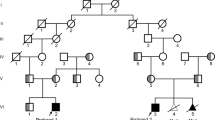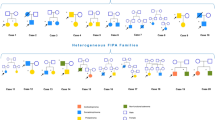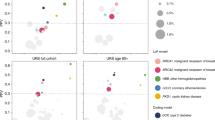Abstract
Two variants (c.[301_302delAG];[301_302delAG] and c.[150delA];[150delA]) in the PROP1 gene are the most common genetic causes of recessively inherited combined pituitary hormones deficiency (CPHD). Our objective was to analyze in detail the origin of the two most prevalent variants. In the multicentric study were included 237 patients with CPHD and their 15 relatives carrying c.[301_302delAG];[301_302delAG] or c.[150delA];[150delA] or c.[301_302delAG];[ 150delA]. They originated from 21 different countries worldwide. We genotyped 21 single-nucleotide variant markers flanking the 9.6-Mb region around the PROP1 gene that are not in mutual linkage disequilibrium in the general populations – a finding of a common haplotype would be indicative of ancestral origin of the variant. Haplotypes were reconstructed by Phase and Haploview software, and the variant age was estimated using an allelic association method. We demonstrated the ancestral origin of both variants – c.[301_302delAG] was carried on 0.2 Mb-long haplotype in a majority of European patients arising ~101 generations ago (confidence interval 90.1–116.4). Patients from the Iberian Peninsula displayed a different haplotype, which was estimated to have emerged 23.3 (20.1–29.1) generations ago. Subsequently, the data indicated that both the haplotypes were transmitted to Latin American patients ~13.8 (12.2–17.0) and 16.4 (14.4–20.1) generations ago, respectively. The c.[150delA] variant that was carried on a haplotype spanning about 0.3 Mb was estimated to appear 43.7 (38.4–52.7) generations ago. We present strong evidence that the most frequent variants in the PROP1 gene are not a consequence of variant hot spots as previously assumed, but are founder variants.
Similar content being viewed by others
Log in or create a free account to read this content
Gain free access to this article, as well as selected content from this journal and more on nature.com
or
References
Sornson MW, Wu W, Dasen JS et al: Pituitary lineage determination by the Prophet of Pit-1 homeodomain factor defective in Ames dwarfism. Nature 1996; 384: 327–333.
Wu W, Cogan JD, Pfaffle RW et al: Mutations in PROP1 cause familial combined pituitary hormone deficiency. Nat Genet 1998; 18: 147–149.
Stenson PD, Mort M, Ball EV, Shaw K, Phillips A, Cooper DN : The Human Gene Mutation Database: building a comprehensive mutation repository for clinical and molecular genetics, diagnostic testing and personalized genomic medicine. Hum Genet 2014; 133: 1–9.
Krzisnik C, Kolacio Z, Battelino T, Brown M, Parks JS, Laron Z : The 'little people' of the island of Krk - revisited. Etiology of hypopituitarism revealed. J Endocr Genet 1999; 1: 9–19.
Strachan T, Read A : Human Molecular Genetics. 4th edn. Garland Science: New York, NY, USA, 2010.
Cogan JD, Wu W, Phillips JA 3rd et al: The PROP1 2-base pair deletion is a common cause of combined pituitary hormone deficiency. J Clin Endocrinol Metab 1998; 83: 3346–3349.
Fofanova OV, Takamura N, Kinoshita E et al: A mutational hot spot in the Prop-1 gene in Russian children with combined pituitary hormone deficiency. Pituitary 1998; 1: 45–49.
Lebl J, Vosahlo J, Pfaeffle RW et al: Auxological and endocrine phenotype in a population-based cohort of patients with PROP1 gene defects. Eur J Endocrinol 2005; 153: 389–396.
Lemos MC, Gomes L, Bastos M et al: PROP1 gene analysis in Portuguese patients with combined pituitary hormone deficiency. Clin Endocrinol (Oxf) 2006; 65: 479–485.
Navardauskaite R, Dusatkova P, Obermannova B et al: High prevalence of PROP1 defects in Lithuania: phenotypic findings in an ethnically homogenous cohort of patients with multiple pituitary hormone deficiency. J Clin Endocrinol Metab 2014; 99: 299–306.
Deladoey J, Fluck C, Buyukgebiz A et al: 'Hot spot' in the PROP1 gene responsible for combined pituitary hormone deficiency. J Clin Endocrinol Metab 1999; 84: 1645–1650.
Mendonca BB, Osorio MG, Latronico AC, Estefan V, Lo LS, Arnhold IJ : Longitudinal hormonal and pituitary imaging changes in two females with combined pituitary hormone deficiency due to deletion of A301,G302 in the PROP1 gene. J Clin Endocrinol Metab 1999; 84: 942–945.
Mody S, Brown MR, Parks JS : The spectrum of hypopituitarism caused by PROP1 mutations. Best Pract Res Clin Endocrinol Metab 2002; 16: 421–431.
Osorio MG, Marui S, Jorge AA et al: Pituitary magnetic resonance imaging and function in patients with growth hormone deficiency with and without mutations in GHRH-R, GH-1, or PROP-1 genes. J Clin Endocrinol Metab 2002; 87: 5076–5084.
Altshuler DM, Gibbs RA, Peltonen L et al: Integrating common and rare genetic variation in diverse human populations. Nature 2010; 467: 52–58.
Dusatkova P, Pruhova S, Borowiec M et al: Ancestral mutations may cause a significant proportion of GCK-MODY. Pediatr Diabetes 2012; 13: 489–498.
Barrett JC, Fry B, Maller J, Daly MJ : Haploview: analysis and visualization of LD and haplotype maps. Bioinformatics 2005; 21: 263–265.
Stephens M, Smith NJ, Donnelly P : A new statistical method for haplotype reconstruction from population data. Am J Hum Genet 2001; 68: 978–989.
Austerlitz F, Kalaydjieva L, Heyer E : Detecting population growth, selection and inherited fertility from haplotypic data in humans. Genetics 2003; 165: 1579–1586.
Matise TC, Chen F, Chen W et al: A second-generation combined linkage physical map of the human genome. Genome Res 2007; 17: 1783–1786.
de Graaff LCG : PROP1-related combined pituitary hormone deficiency. in Pagon RA, Adam MP, Bird TD (eds): GeneReviews® [Internet]. University of Washington, Seattle, WA, USA, 2000.
Halasz Z, Toke J, Patocs A et al: High prevalence of PROP1 gene mutations in Hungarian patients with childhood-onset combined anterior pituitary hormone deficiency. Endocrine 2006; 30: 255–260.
Genin E, Tullio-Pelet A, Begeot F, Lyonnet S, Abel L : Estimating the age of rare disease mutations: the example of Triple-A syndrome. J Med Genet 2004; 41: 445–449.
Reeve JP, Rannala B : DMLE+: Bayesian linkage disequilibrium gene mapping. Bioinformatics 2002; 18: 894–895.
Slatkin M, Rannala B : Estimating the age of alleles by use of intraallelic variability. Am J Hum Genet 1997; 60: 447–458.
Krzisnik C, Grguric S, Cvijovic K, Laron Z : Longevity of the hypopituitary patients from the Island Krk: A follow-up study. Pediatr Endocrinol Rev 2010; 7: 357–361.
de Graaff LC, Argente J, Veenma DC, Drent ML, Uitterlinden AG, Hokken-Koelega AC : PROP1, HESX1, POU1F1, LHX3 and LHX4 mutation and deletion screening and GH1 P89L and IVS3+1/+2 mutation screening in a Dutch nationwide cohort of patients with combined pituitary hormone deficiency. Horm Res Paediatr 2010; 73: 363–371.
Richards RI, Sutherland GR : Simple repeat DNA is not replicated simply. Nat Genet 1994; 6: 114–116.
Acknowledgements
We are grateful to attending endocrinologists and Professor Szalecki (Faculty of Health Sciences Jan Kochanowski University, Kielce, Poland) who provided the samples of their patients for the study. We also thank the participants (patients and their relatives from all countries). The study was supported by Eli Lilly IIT (grant number B9R-CY-O057), the Internal Grant Agency of the Czech Ministry of Health (grant number NT13692) and by the project for conceptual development of research organization 00064203/6001 (Ministry of Health, the Czech Republic).
Author information
Authors and Affiliations
Corresponding author
Ethics declarations
Competing interests
P.D., M.R.B., R.W.P., J.S.P. and J.L. have previously consulted for and received grant support from Eli Lilly and Company. W.F.B. was previously employed by and has equity interests in Eli Lilly and Company. Other authors declare no potential conflict of interest.
Additional information
Supplementary Information accompanies this paper on European Journal of Human Genetics website
Supplementary information
Rights and permissions
About this article
Cite this article
Dusatkova, P., Pfäffle, R., Brown, M. et al. Genesis of two most prevalent PROP1 gene variants causing combined pituitary hormone deficiency in 21 populations. Eur J Hum Genet 24, 415–420 (2016). https://doi.org/10.1038/ejhg.2015.126
Received:
Revised:
Accepted:
Published:
Issue date:
DOI: https://doi.org/10.1038/ejhg.2015.126
This article is cited by
-
Genetic analysis of adult Slovenian patients with combined pituitary hormone deficiency
Endocrine (2019)
-
Growth hormone — past, present and future
Nature Reviews Endocrinology (2018)
-
Genetic screening of regulatory regions of pituitary transcription factors in patients with idiopathic pituitary hormone deficiencies
Pituitary (2018)
-
Combined pituitary hormone deficiency due to gross deletions in the POU1F1 (PIT-1) and PROP1 genes
Journal of Human Genetics (2017)



